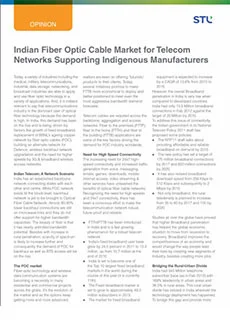Today, a variety of industries including the medical, military, telecommunications, industrial, data storage, networking, and broadcast industries are able to apply and use fibre optic technology in a variety of applications. And, it is indeed relevant to say that telecommunications industry is the dominant user of optical fibre technology because the demand is high. In India, this demand has been on the rise and is being driven by factors like growth of fixed broadband, replacement of BSNL’s ageing copper network by fibre optic cables (FOC), building an alternate network for Defence, wireless backhaul network up gradation and the need for higher speeds by 3G & broadband wireless access networks. India has an established backbone network connecting states with each other and centre. While FOC network exists till the block level, backhaul network is yet to be brought to Optical Fibre Cable Network. Almost 80-90% tower backhaul connections are still on microwave links and they do not offer support for higher bandwidth capacities. The beauty of fiber is that it has nearly unlimited bandwidth potential. Besides with increase in rural penetration, scarcity of spectrum is likely to increase further and consequently the demand of FOC for backhaul as well as BTS access will be on the rise.
Indian Telecom: A Network Scenario
India has an established backbone network connecting states with each other and centre. While FOC network exists till the block level, backhaul network is yet to be brought to Optical Fiber Cable Network. Almost 80-90% tower backhaul connections are still on microwave links and they do not offer support for higher bandwidth capacities. The beauty of fiber is that it has nearly unlimited bandwidth potential. Besides with increase in rural penetration, scarcity of spectrum is likely to increase further and consequently the demand of FOC for backhaul as well as BTS access will be on the rise.
The FOC market
Fiber-optic technology and wireless data communication systems are becoming a necessity in many residential and commercial projects across the globe. It’s the evolution of the market and as the options keep getting more and more advanced, realtors are keen on offering ‘futuristic’ products to their clients. Today, several initiatives promise to make FTTB more economical to deploy and better positioned to meet even the most aggressive bandwidth demand forecasts.
Telecom cables are required across the backbone, aggregation and access networks. Fiber to the premises (FTTP), fiber to the home (FTTH) and fiber to the building (FTTB) applications are some of the key factors driving the demand for FOC industry worldwide.
Need for High Speed Connectivity
The increasing need for 24×7 highspeed connectivity and increased traffic generation from voice, messaging, emails, games, downloads, mobile internet access, video streaming & other services have unleashed the benefits of optical fiber cable networks. Recognizing the need for high speeds and 24×7 connectivity, there has been a conscious effort to make the telecommunication network robust, future proof and reliable.
- FTTH/FTTB has been introduced in India and is a fast growing phenomenon for a robust telecom network
- India’s fixed broadband user base grew by 24.5 percent in 2011 to 13.3 million, up from 10.7 million at the end of 2010
- India is set to become one of the Top 10 largest fixed broadband markets in the world during the course of this year (it is currently 11th)
- The Fixed broadband market is set to grow to approximately 49.3 million subscribers in 2015
- The market for fixed broadband equipment is expected to increase by a CAGR of 13.6% from 2010 to 2015
However, the overall Broadband penetration in India is very low when compared to developed countries. India had only 13.5 Million broadband connections in Feb 2012 against the target of 20 Million by 2010.
To address this issue of connectivity, the Indian government in its National Telecom Policy 2011 draft has proposed some policies:
- The NTP’11 draft talks about providing affordable and reliable broadband on demand by 2015
- The new policy has set a target of 175 million broadband connections by 2017 and 600 million connections by 2020
- It has also revised broadband download speed from 256 Kbps to 512 Kbps and subsequently to 2 Mbps by 2015
- Not only broadband, the rural teledensity is planned to increase from 35 to 60 by 2017 and 100 by 2020
Studies all over the globe have proved that higher Broadband penetration has helped the global economic situation to move from recession to recovery. Broadband improves the competitiveness of an economy and would change the way people lead their lives by creating new segments of Industry, besides creating more jobs.
Bridging the Rural-Urban Divide
India had 943 Million telephone subscriber base (as in Feb 2012) with 169% teledensity in urban areas and Indian Telecom – Key Parameters 38.5% in rural areas. This rural urban divide has existed in India wherever the technology deployment has happened. To bridge this gap and provide more services, NOFN is being designed with an objective to extend optical fiber network to gram panchayat. Broadband penetration also acts as an indicator to overall GDP growth, 10% increase in broadband penetration leads to 1.2-1.3% increase in GDP.
India’s Fiber Manufacturing Capability
Optical Fiber deployment in India started as early as in 1990, but then there was no local manufacturer. The entire optical fiber requirement had to be met through imports. Now the scenario has changed. Though the market consumption over the last two years has been less than 6 Mn fKm, Indian fiber manufacturing capacity is on a rise. With 4 main manufacturers, India boasts of reaching 28 Million fKm capacities (optical fiber) by 2013. Capacity for FOC (Fiber Optic Cable) manufacturing in India is approximately 8 Lakh Cable KM. More global players are eyeing to setup their plants or have tie-ups in India. Thus India can domestically meet the upcoming requirements for National Optical Fiber Network. Making these sourcing from domestic manufacturers, will not only suffice this projects requirement of resources but in fact provide a great impetus to boast domestic market, save on foreign currency, promote R&D and provide high quality evolving products for evolving Indian ICT industry.
Supporting the Indigenous Fiber Manufacturing Industry
India is one of the promising markets for the growth of fiber optics among the developing countries. Indian fiber optic cable manufacturers have been making their efforts to meet the internal demand for fiber optic cables. However, it is imperative that manufacturers of optical fibers receive total support to ensure sustainable development of the overall economy.
Projected Estimates
In fact, most developed economies have set up policies and frameworks that favour their own indigenous manufacturers against foreign players. Several initiatives like tax incentives, substantial project subsidies and financial support for R&D have assisted domestic industries in countries like China to come a long way from being an importer to a large exporter of technology products.
Benefits of sourcing optical fiber and optical fiber cable from indigenous manufacturers
- Logistics support and timely delivery of supplies
- Help avoid security & information leak
- Creating huge value as well as large employment
- Complete process control and if required inspection at all stages at any point of time
- Committed to future supplies required for Network maintenance/ replacement purpose
- 24 X 7 personalized Technical support on product performance
- Test facilities available domestically
- Network Ownership – further maintenance and installation becomes easier



